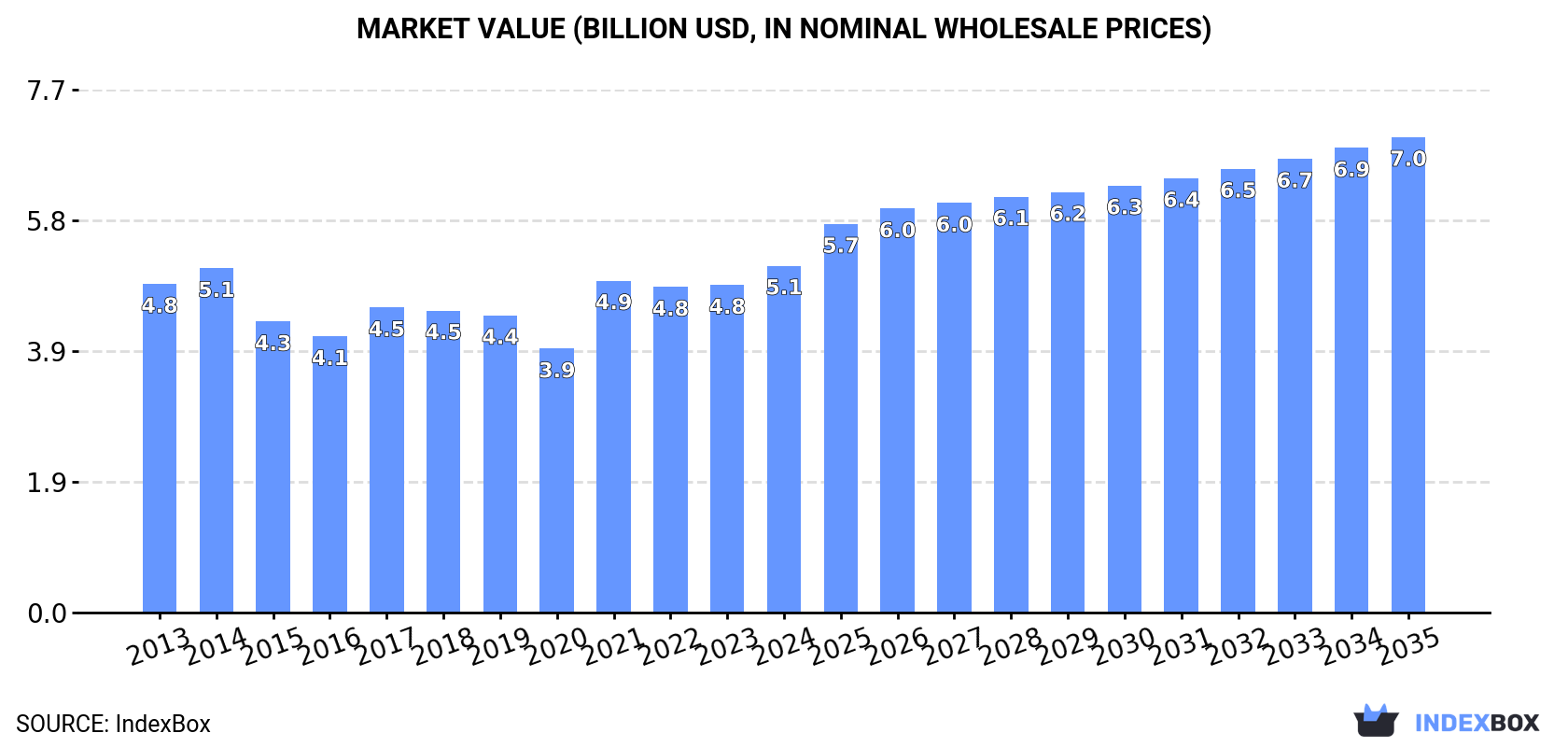Jun 23, 2025
IndexBox has just published a new report: Middle East – Benzene – Market Analysis, Forecast, Size, Trends And Insights.
The benzene market in the Middle East is expected to experience steady growth, with a forecasted CAGR of +1.9% in volume and +2.9% in value from 2024 to 2035. This growth is driven by rising demand for benzene in the region, leading to an anticipated increase in market volume and value by the end of the forecast period.
Market Forecast
Driven by increasing demand for benzene in the Middle East, the market is expected to continue an upward consumption trend over the next decade. Market performance is forecast to retain its current trend pattern, expanding with an anticipated CAGR of +1.9% for the period from 2024 to 2035, which is projected to bring the market volume to 6.5M tons by the end of 2035.
In value terms, the market is forecast to increase with an anticipated CAGR of +2.9% for the period from 2024 to 2035, which is projected to bring the market value to $7B (in nominal wholesale prices) by the end of 2035.
 ConsumptionMiddle East’s Consumption of Benzene
ConsumptionMiddle East’s Consumption of Benzene
In 2024, consumption of benzene in the Middle East reached 5.3M tons, picking up by 3.4% on the previous year. The total consumption volume increased at an average annual rate of +1.6% from 2013 to 2024; the trend pattern remained relatively stable, with somewhat noticeable fluctuations in certain years. The most prominent rate of growth was recorded in 2023 when the consumption volume increased by 5.7%. The volume of consumption peaked in 2024 and is expected to retain growth in years to come.
The size of the benzene market in the Middle East was estimated at $5.1B in 2024, surging by 5.9% against the previous year. This figure reflects the total revenues of producers and importers (excluding logistics costs, retail marketing costs, and retailers’ margins, which will be included in the final consumer price). Over the period under review, consumption recorded a relatively flat trend pattern. Over the period under review, the market attained the maximum level in 2024 and is expected to retain growth in the immediate term.
Consumption By Country
The countries with the highest volumes of consumption in 2024 were Turkey (1.6M tons), Iran (1.2M tons) and Saudi Arabia (1.1M tons), together comprising 73% of total consumption. Iraq, Israel, the United Arab Emirates and Oman lagged somewhat behind, together comprising a further 24%.
From 2013 to 2024, the biggest increases were recorded for Oman (with a CAGR of +6.9%), while consumption for the other leaders experienced more modest paces of growth.
In value terms, Turkey ($1.6B), Iran ($1.1B) and Saudi Arabia ($1.1B) appeared to be the countries with the highest levels of market value in 2024, together accounting for 74% of the total market. Iraq, Israel, the United Arab Emirates and Oman lagged somewhat behind, together comprising a further 23%.
Among the main consuming countries, Oman, with a CAGR of +5.1%, recorded the highest rates of growth with regard to market size over the period under review, while market for the other leaders experienced more modest paces of growth.
The countries with the highest levels of benzene per capita consumption in 2024 were Israel (36 kg per person), Oman (32 kg per person) and Saudi Arabia (29 kg per person).
From 2013 to 2024, the most notable rate of growth in terms of consumption, amongst the key consuming countries, was attained by Oman (with a CAGR of +3.3%), while consumption for the other leaders experienced more modest paces of growth.
ProductionMiddle East’s Production of Benzene
In 2024, approx. 5.2M tons of benzene were produced in the Middle East; surging by 6.4% against the year before. The total output volume increased at an average annual rate of +1.3% over the period from 2013 to 2024; the trend pattern remained consistent, with only minor fluctuations throughout the analyzed period. The most prominent rate of growth was recorded in 2018 when the production volume increased by 14%. As a result, production reached the peak volume of 5.3M tons. From 2019 to 2024, production growth failed to regain momentum.
In value terms, benzene production rose notably to $4.9B in 2024 estimated in export price. Over the period under review, production recorded a relatively flat trend pattern. The growth pace was the most rapid in 2021 when the production volume increased by 39%. Over the period under review, production hit record highs in 2024 and is likely to see gradual growth in years to come.
Production By Country
The countries with the highest volumes of production in 2024 were Turkey (1.7M tons), Iran (1.3M tons) and Saudi Arabia (599K tons), together comprising 71% of total production. Iraq, Israel, Oman and the United Arab Emirates lagged somewhat behind, together accounting for a further 28%.
From 2013 to 2024, the biggest increases were recorded for Iraq (with a CAGR of +1.8%), while production for the other leaders experienced more modest paces of growth.
ImportsMiddle East’s Imports of Benzene
In 2024, approx. 645K tons of benzene were imported in the Middle East; waning by -17.7% compared with the year before. In general, imports, however, recorded a relatively flat trend pattern. The pace of growth appeared the most rapid in 2017 with an increase of 44% against the previous year. The volume of import peaked at 1M tons in 2019; however, from 2020 to 2024, imports failed to regain momentum.
In value terms, benzene imports declined to $662M in 2024. Over the period under review, imports recorded a slight contraction. The pace of growth was the most pronounced in 2017 with an increase of 90% against the previous year. Over the period under review, imports hit record highs at $988M in 2014; however, from 2015 to 2024, imports stood at a somewhat lower figure.
Imports By Country
In 2024, Saudi Arabia (522K tons) represented the largest importer of benzene, achieving 81% of total imports. Kuwait (77K tons) held the second position in the ranking, distantly followed by Syrian Arab Republic (32K tons). All these countries together held near 17% share of total imports.
Imports into Saudi Arabia increased at an average annual rate of +1.5% from 2013 to 2024. At the same time, Syrian Arab Republic (+17.1%) displayed positive paces of growth. Moreover, Syrian Arab Republic emerged as the fastest-growing importer imported in the Middle East, with a CAGR of +17.1% from 2013-2024. By contrast, Kuwait (-4.7%) illustrated a downward trend over the same period. While the share of Saudi Arabia (+6 p.p.) and Syrian Arab Republic (+4 p.p.) increased significantly in terms of the total imports from 2013-2024, the share of Kuwait (-10.1 p.p.) displayed negative dynamics.
In value terms, Saudi Arabia ($533M) constitutes the largest market for imported benzene in the Middle East, comprising 81% of total imports. The second position in the ranking was held by Kuwait ($79M), with a 12% share of total imports.
From 2013 to 2024, the average annual rate of growth in terms of value in Saudi Arabia stood at -1.4%. In the other countries, the average annual rates were as follows: Kuwait (-6.6% per year) and Syrian Arab Republic (+17.1% per year).
Import Prices By Country
In 2024, the import price in the Middle East amounted to $1,026 per ton, rising by 7.2% against the previous year. Overall, the import price, however, saw a perceptible descent. The growth pace was the most rapid in 2021 an increase of 72% against the previous year. The level of import peaked at $1,385 per ton in 2013; however, from 2014 to 2024, import prices failed to regain momentum.
Average prices varied noticeably amongst the major importing countries. In 2024, amid the top importers, the country with the highest price was Syrian Arab Republic ($1,161 per ton), while Saudi Arabia ($1,021 per ton) was amongst the lowest.
From 2013 to 2024, the most notable rate of growth in terms of prices was attained by Kuwait (-2.1%).
ExportsMiddle East’s Exports of Benzene
For the third consecutive year, the Middle East recorded decline in shipments abroad of benzene, which decreased by -0.4% to 509K tons in 2024. Over the period under review, exports continue to indicate a slight decline. The most prominent rate of growth was recorded in 2018 with an increase of 95%. As a result, the exports attained the peak of 1.2M tons. From 2019 to 2024, the growth of the exports remained at a somewhat lower figure.
In value terms, benzene exports expanded to $491M in 2024. Overall, exports showed a perceptible contraction. The pace of growth was the most pronounced in 2021 when exports increased by 83%. The level of export peaked at $862M in 2018; however, from 2019 to 2024, the exports stood at a somewhat lower figure.
Exports By Country
In 2024, Iran (143K tons), Oman (114K tons), Turkey (105K tons) and Israel (84K tons) was the main exporter of benzene in the Middle East, committing 88% of total export. It was distantly followed by Saudi Arabia (55K tons), creating an 11% share of total exports. The United Arab Emirates (8.8K tons) followed a long way behind the leaders.
From 2013 to 2024, the most notable rate of growth in terms of shipments, amongst the main exporting countries, was attained by Iran (with a CAGR of +21.9%), while the other leaders experienced mixed trends in the exports figures.
In value terms, Iran ($120M), Oman ($111M) and Turkey ($110M) appeared to be the countries with the highest levels of exports in 2024, together accounting for 69% of total exports.
Iran, with a CAGR of +19.7%, saw the highest growth rate of the value of exports, among the main exporting countries over the period under review, while shipments for the other leaders experienced a decline in the exports figures.
Export Prices By Country
The export price in the Middle East stood at $964 per ton in 2024, picking up by 5.2% against the previous year. Over the period under review, the export price, however, continues to indicate a pronounced reduction. The growth pace was the most rapid in 2021 an increase of 64%. The level of export peaked at $1,300 per ton in 2014; however, from 2015 to 2024, the export prices failed to regain momentum.
Average prices varied somewhat amongst the major exporting countries. In 2024, major exporting countries recorded the following prices: in Israel ($1,050 per ton) and Turkey ($1,049 per ton), while the United Arab Emirates ($755 per ton) and Iran ($838 per ton) were amongst the lowest.
From 2013 to 2024, the most notable rate of growth in terms of prices was attained by Israel (-1.1%), while the other leaders experienced a decline in the export price figures.
Source: IndexBox Market Intelligence Platform
